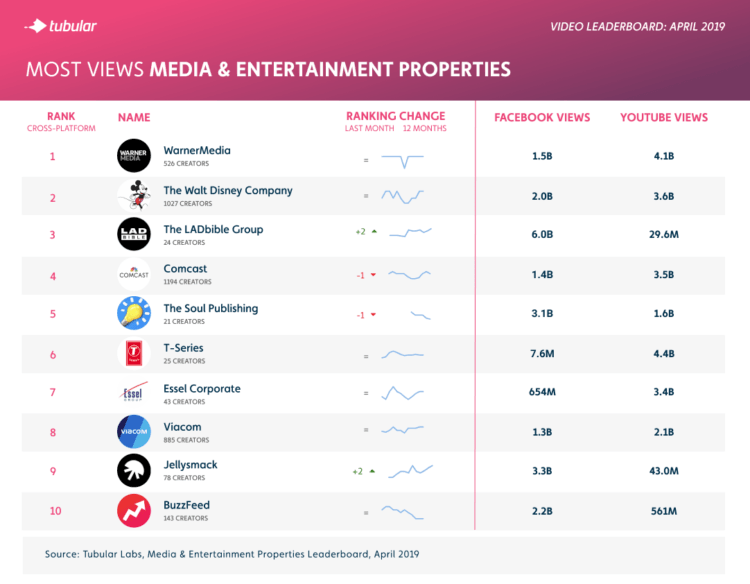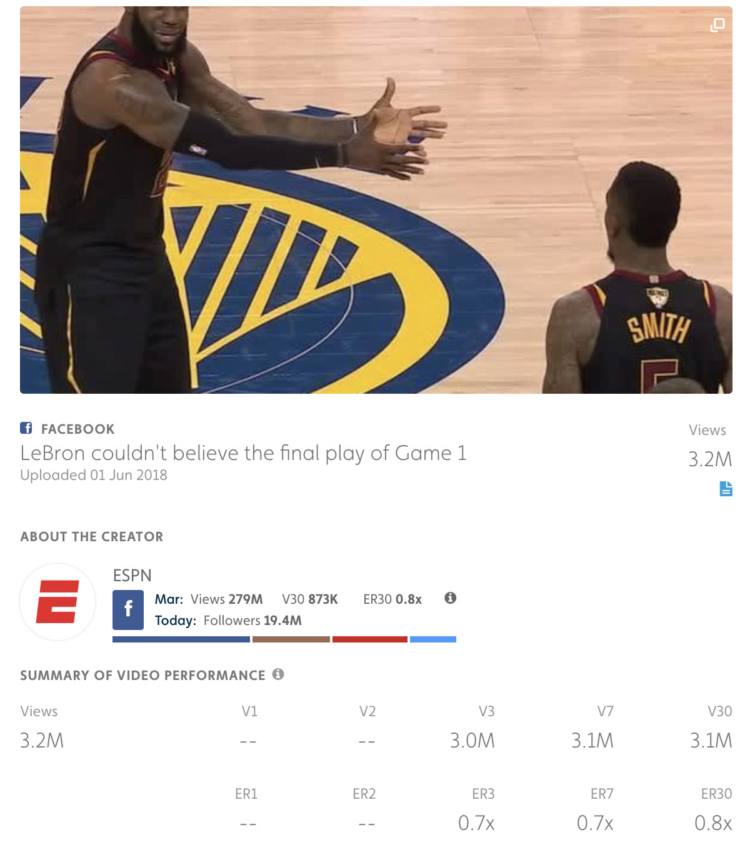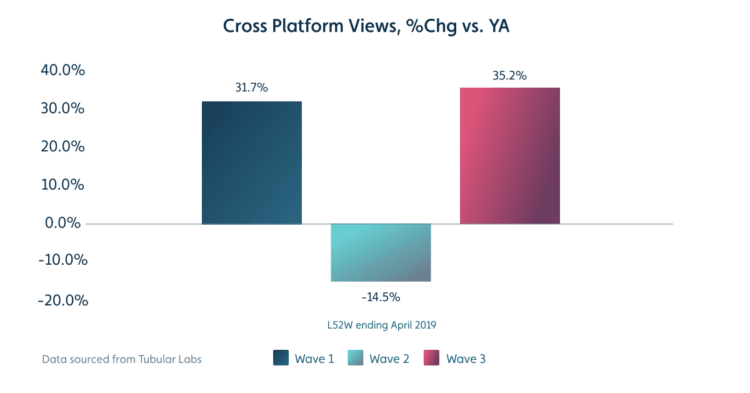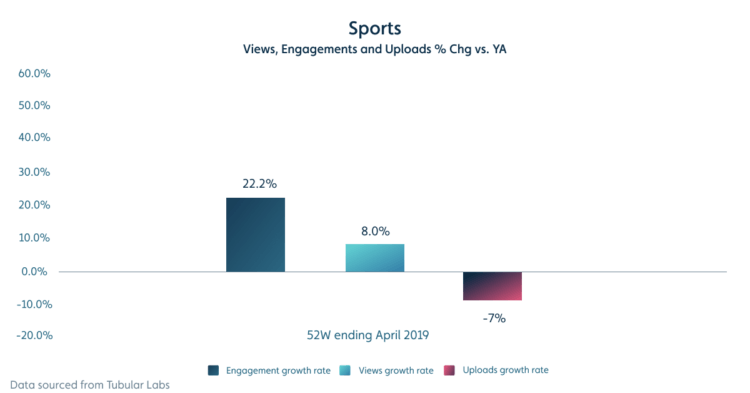A few years ago, a new class of digital-first publishers, led by the likes of BuzzFeed and Bleacher Report, began rapidly growing audiences.
They redefined entertainment for digital audiences and began fueling demand among content-hungry audiences for video experiences designed for consumption on platforms like YouTube and Facebook.
Today, broadcast and media companies are quickly catching up and successfully competing for the attention of online audiences by repositioning linear programs for the digital-first consumption habits of their growing digital audiences.

If you’re in sports media, this is no surprise! The vertical has historically experienced lots of disruption.
Video Is Redefining Sports Media… Again
Beginning in the ’80s, the success of ESPN and the 24-hour sports network proved that there was an unmet demand for sports-related content like the highlight reel, forever changing the way sports entertainment was consumed.
The recent explosion of digital video has given fans more touchpoints than ever before to go beyond the barstool and highlight reel to remain connected with their favorite teams, celebrity athletes, and reporting channels.
Consequently, this group has different expectations for the types of content they engage with.
To be successful in this highly competitive marketplace, content creators must keep up with rapidly changing consumer preferences.
One group (which we’ll dive into below) has found innovative ways to grow a more engaged and valuable audience with content that’s literally at their fingertips.
The Who’s-Who of Sports Entertainment in Video
So how have broadcasters taken sports entertainment beyond the collective watching experience, watercooler conversations of the past, and past the ever-present highlight reel into the latest era of the always-connected fan?
Let’s breakdown the sports content ecosystem into three waves.
Wave 1: The Rights Holders
These are the content owners, including networks like ESPN, Turner, Fox, NBC, CBS, and even the leagues themselves (NFL, NBA, MLB, etc.).
Their video strategy tends to be the repurposing of game moments and interviews for the typical highlight reel or two. Here’s an example of a top-performing video from ESPN:

LeBron’s infamous frustration with JR in game 1 of the 2018 NBA finals had 3M views 3 days after publication and an engagement rate of 0.7x the average video in the same timeframe.
Wave 2: The Reporting Channels and Content Creators
This group of content producers and broadcasters translate traditional reporting methods to the digital-first world on social platforms and include properties like Bleacher Report, SB Nation, Sports Illustrated, Sporting News, and FanSided.
Their strategy is a mix of humorous content and unexpected feats which have high engagement rates. Here’s an example:
Humoristic content gets a lot of immediate buzz. The “The Champions Season 2” video had an ER3 of 5.4x.
Unexpected feats — in this case, kids doing the extraordinary — draw high fan engagement (ER30 2.0X) and views (V30 12.9M.
Wave 3: The Connectors
This group is skilled at connecting the dots between fans and their favorite teams by finding new ways to engage them. They optimize for digital-first consumption by repackaging and distributing content tailored for their fans.
Examples include WAVE Sports, Ball is Life, Oh My Goal, Overtime, and Barstool Sports.
Overtime’s content strategy, for example, involves activating up-and-coming athletes like LaMelo Ball to resonate with younger audiences, while formats like the “Overtime Challenge” keep audiences engaged.
In the last year, reporting channels and content creators who once redefined the space began to lose market share to the connectors.
Once the modernized underdog story, has now become a cautionary tale: either give people what they want, where they want it, and fast, or risk becoming lost in the highly competitive content marketplace.

But don’t fret! By leaning into changes in consumption habits and attention spans and not remaining ingrained in traditional ways of distribution, content right’s owners and creators have unlimited opportunities for engagement.
After all, their inherent advantages as right’s owners and creators allow them to be more flexible and responsive.
You’d think with 18 years worth of video being uploaded every day, fans have the sports content they are seeking but based on our analysis, this isn’t true. Today’s sports audience is being underserved.

There is room for more media companies and marketers to capture audience attention. How can you do this? Start with developing audience-first content strategies, like The Connectors.
Related Read: WAVE Sports Case Study
A Key Strategy: Know Your Audience
What does differentiation in video look like, and how do you create authentic experiences for your fans?
For starters, break away from the same narratives. Don’t share the same 10 pieces of content every day. For example, do your fans really need another highlight reel?
As organizations invest more in video content, it’s easy to fall into the trap of pursuing the next viral hit. But trend-chasing without understanding why a particular piece of content was successful is like going into an elimination game without a gameplan.
You may get lucky and win, but most likely, you’re going to lose.
To drive success, content owners and producers need informed content strategies including knowing where your audience is and what they’re watching. Using audience insights, you’ll be able to:
- Uncover which videos perform (and why) to reach beyond typical social analytics and drive consistent performance.
- Determine the variables that define your audience and what (else) they watch
- Benchmark your content against competitors
By following this workflow, you’ll quickly identify topics that appeal to your audience. Social platforms also help you test new audiences and identify partners that fit with this audience.
An example of this is using athletes as activation channels, or leveraging niche creators to quickly scale your content to underserved audiences.
Related Read: Nike Ads Slay Social Video Every Time! Here’s How.
The Importance of Measurement Beyond the Highlight Reel
So you’ve created really engaging content by developing an audience-first content strategy — now what?
In today’s competitive content marketplace, that’s not enough. The highest-performing and top ROI-driving teams regularly assess content performance and operationalize insights with creative.
The core to understanding content performance is being able to answer “what does good look like?”
A quick way is to benchmark your own content performance against other publishers, brands, influencers, and athletes who are vying for the attention of the same audience.
Creating Competitive Advantages Through Fan Engagement
We live in competitive times, but competition also fosters innovation.
Trends will come and go, but our advice is simple: always approach content from an audience-first, platform-specific perspective.
It’s easy to become single-sighted in pursuit of content nirvana, but don’t forget to look beyond your own content to your competitors, creators, and even influencers.
They might just be on to the next big idea.
Want more info on the performance of sports media on social video?